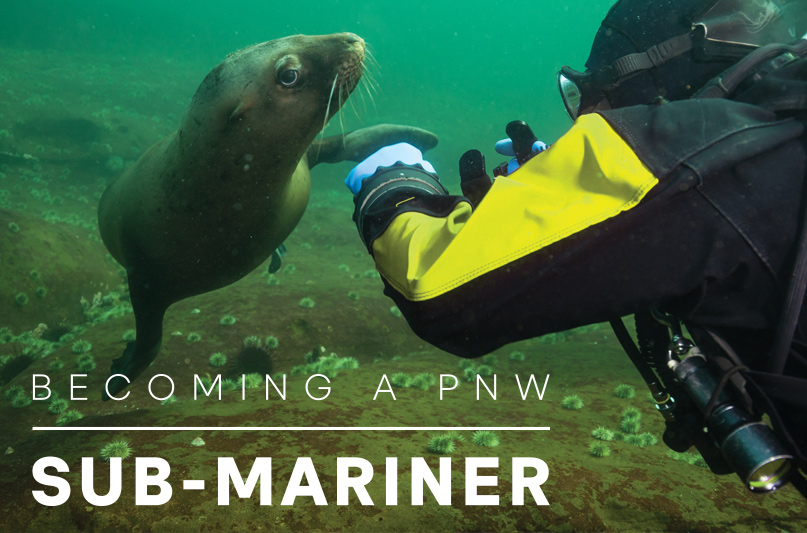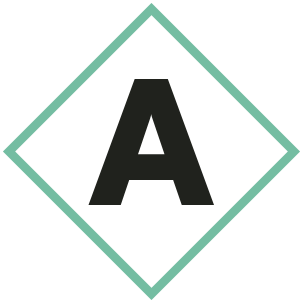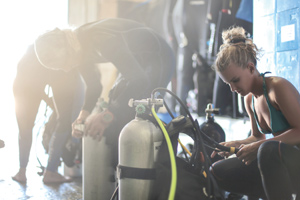
Now it’s time to go under them.
 As a scuba diver, I find it fascinating that relatively few lifelong sea salts venture below the ocean’s surface. Whether I’m nursing a wine glass at a yacht club mixer in Seattle or kicking back a Rainier tallboy at a commercial fisherman’s bar in Westport, the same phrase is likely uttered when broaching the topic of entering the brine: “No thanks! I’ve spent my life on the water, but there’s no way I’m going under.” To my sensibilities, this makes about as much sense as claiming to be a foodie but refusing to try any new cuisines. How do such avid ocean junkies resist at least dabbling in underwater recreation? How can we be content to only see a giant Pacific octopus at the aquarium, or to experience a shipwreck as a mere acoustic silhouette on a multifunction display? No, boaters, the surface is only a taste of the adventure!
As a scuba diver, I find it fascinating that relatively few lifelong sea salts venture below the ocean’s surface. Whether I’m nursing a wine glass at a yacht club mixer in Seattle or kicking back a Rainier tallboy at a commercial fisherman’s bar in Westport, the same phrase is likely uttered when broaching the topic of entering the brine: “No thanks! I’ve spent my life on the water, but there’s no way I’m going under.” To my sensibilities, this makes about as much sense as claiming to be a foodie but refusing to try any new cuisines. How do such avid ocean junkies resist at least dabbling in underwater recreation? How can we be content to only see a giant Pacific octopus at the aquarium, or to experience a shipwreck as a mere acoustic silhouette on a multifunction display? No, boaters, the surface is only a taste of the adventure!
Of course, I empathize with those who yearn to get down there but have yet to navigate the logistics. Getting into scuba diving from square one is no trivial journey. Additionally, while the coastal waters of Puget Sound and north to Alaska are loaded with world-class opportunities, there are several factors at play that don’t exactly make it an idyllic tropical kiddie pool for beginners.
Ultimately, once you’re actively diving locally, there’s even more to think about if you want to make your boat a proper dive platform. I hope to touch on all these topics, with insight from local dive experts, to set up Pacific Northwest boaters turned would-be aquanauts for success.
Firstly, what’s the payoff to Cascadian diving? Jackie Myers, a dive instructor with decades of experience and a school teacher who runs Tacoma-based Bandito Charters with her husband Rick Myers, is quick to tout the unique local sights. Rick started his dive career right here in Seattle’s Diver Institute of Technology on Lake Union before moving to the recreational side in the 70s.
“There’s many species of animals that only live in the Puget Sound area,” Jackie says. “Several species of rockfish are only found here. We also have a big array of nudibranchs—the colorful sea slugs.” Marine mammals like seals and sea lions are relatively common. “Of course, this is one of the best places in the world to see giant Pacific octopus.”
The Myers’ are very familiar with the iconic cephalopod, a crowd favorite among octopus lovers. For anyone acquainted with the History Channel’s Monster Quest show, their charter boat Sampan — a wooden Youngquist commercial boat turned dive charter — is featured in Season Two’s episode 11, which is about trying to track down the fantastical 200-foot “octopus giganticus,” rumored to live in the Tacoma Narrows.
“You really don’t know when they’re filming what the final video is actually going to be like,” Rick chuckles. While octo-Sasquatch remains fiction, the real deal can commonly be found on drift dives through the Tacoma Narrows. There’s even a designated Octopus Hole Conservation Area in Hood Canal. As the name implies, giant octopus are common on the shelf of a natural submarine hole.

“A lot of people incorrectly think there’s not as much color down there as say a coral reef,” says Jackie. “The funny thing is, you just need a powerful light to reveal all the brilliant reds and oranges. It’s just packed with life down there, but you’re usually deeper and physics dictate that you need more powerful lighting to truly see the colors.”
What’s more, there’s several interesting manmade sights of note to tempt local divers. The Edmonds Dive Park is one such area, essentially an underwater collection of sunken structures for divers to explore within striking distance of shore. There are many more, from the Maury Island Barges’ shipwreck off Vashon Island to the Diamond Knot shipwreck site near Port Angeles. Each has its own history, adding another dimension to the already impressive diving opportunity.
Alright, so there’s plenty to see down there—maybe even octo-Sasquatch—and you want in. Assuming that you have your basic diver certification, our area offers several challenges that must be taken into account. The three big ones are currents, temperature, and visibility.
Seasoned Salish Sea boaters know all about our intense tidal swings. Suffice it to say that our tides are like this because of the restrictive nature of our glacially carved geography. Basically, the smaller the channel a mass of water is forced through, the faster the water moving through it becomes. You toy with this concept yourself when you adjust the settings on your yard hose; the hard jet stream is made by reducing the opening and the fatter, relaxed stream results from the hose head opened all the way.
“The currents around here are a major factor,” says Rick. For example, the Tacoma Narrows regularly clocks in a current speed of over 5 knots, a decent clip on many sailboats. “You have to do your homework and know what you’re getting into. Also, whoever is operating the dive platform on the surface during the dive has to be on it. In many ways, the person in the boat has to be the most vigilant.” Not only does the boat operator have to stay on specific coordinates regardless of sea state but picking up divers in a brisk tide current can be a challenge.
“A diver can get away from you, and you have to think of how best to intercept them,” says Jackie. However, as daunting as the currents can be, they also make drift diving a tempting reality. If you can time your dive properly and coordinate with your boat on where to meet, you can dive in these currents to essentially fly effortlessly for miles underwater. An adrenaline rush and magical experience, if done right. While becoming the master of our currents is in some ways a lifelong process of learning, there’s only so much one can do with regards to visibility.
“The visibility in Puget Sound is largely effected by runoff brought on by heavy rains and planktonic blooms,” says Rick. “Last year, for example, we had a rainy winter and the diving was lousy for many months. This year we’ve had a sunny winter and it’s been fantastic diving.”
Avoiding poor visibility due to runoff is mostly a matter of avoiding the days before and after heavy rains, while the plankton is more of a wildcard. Essentially, a plankton bloom needs two primary ingredients to happen: nutrients and sunlight. Nutrients come in many forms, including nitrates from sewage spills (or *cough, cough*—illegally emptied wastewater tanks of vessels). Unless you’re following the water quality and scientific literature like a scrappy oceanography PhD candidate, you’re probably going to be keeping an eye on the sun (or lack thereof).
“When it’s sunny, a plankton bloom can happen, clouding up the water,” says Rick. “There’s a lifecycle to it: the plankton will bloom, then die off. Usually it’ll happen a lot in the summer.” Warmer water temperatures also contribute to planktonic blooms. The solution? Dive in the colder months. “Winter is often the best time of year to dive from a visibility standpoint.”
The topic of winter and lack of sun leads into the third big consideration: temperature. While most scuba diving pictures show off smiling models in swimsuits and white sand, you’ll want to come layered up properly to our waters.

“I dove today [March 17], and the temperature at-depth was in the 40s,” says Jackie. “Even in the summer, once you’re at-depth, it’s usually in the 50s.” Conventional diving wisdom states that when you’re dealing with temperatures below 50 degrees, you’re going to want to go for a heavy 7- or 8-mm wetsuit or a drysuit. It’s important to keep in mind that everyone’s internal thermostat acts a little differently. Erring on the side of too much and embracing experimentation over a few dives is probably the best way to hone your system for maintaining warmth in cold waters.
For those wondering, the difference between a wetsuit and drysuit is implied in the names. A wetsuit traps a layer of water between the suit and diver’s body. As heat leaves the diver’s body, it becomes trapped in that layer of water, creating an insulating layer. A drysuit completely encases the diver, keeping him or her out of water altogether while also trapping the heat.
You have your certification, and you’ve carefully considered the area’s currents, visibility, and temperature factors. You’ve even chartered a few local dives—maybe with Rick and Jackie—to master these considerations in the field and learn some local trips. Ideally you’ve even risen up through the Advanced and Rescue Diver certification levels.
Now, you’re eyeing your own boat and licking your chops to dive off your own hull. What’s next?
“There’s a lot of ways to skin the cat and it’s fun to see what boaters come up with,” says Rick. “You see people diving off all kinds of boats, big and small.” While ingenuity can go a long way, there’s no denying that some boats are just naturally predisposed to being good dive platforms. The work boat past of Sampan sets her up as a great charter for a few reasons, the start being inside the cabin.
Rick shows off the boat’s large medical kit and AED in the V-berth, secured and easily accessible. The V-berth can be closed off for those who want a little privacy while changing. The cabin is always kept warm, in part thanks to the giant, cast iron diesel stovetop with hot coffee and the like ready to go. Food and water are always handy, important as diving burns up a lot of calories and it’s easy to get dehydrated. These may seem to be mere creature comforts, but having a sheltered space like this is a good idea. “You really want people to be able to get warm and dry,” says Rick. Diver Alert Network (DAN) training and basic CPR/First Aid are highly recommended to be fully prepared for dive-related emergencies.
Moving out onto the deck, Sampan shows off the large work space where commercial fishermen in days of yore earned their pay. Rick and Jackie have converted the deck to be open and clutter free, allowing for plenty of maneuvering space for a dozen diving clients wearing awkward gear.
Notably, Rick has rigged up a series of bungie loops secured into a custom wood panel that runs along the inside of the boat. Simple and effective, these bungies can be easily looped around aluminum tanks to keep them in place. Companies make and fabricate hard plastic and metal holding mounts for tanks as well. Regardless of whether you make something or buy something, securing the tanks is vital for safety, yet you also have to keep them accessible to take them on and off.
Sampan also has sitting-level bench seating running along most of the interior of the cockpit aft, with the tank bungies positioned so a secured tank can stand on the benches. Having a secure space like this to sit is very helpful for taking tanks and buoyancy compensation devices (BCDs) off and on.

As far as signaling to other boaters, you’re to fly two flags and have a specific light scheme ready. Believe it or not, the red and white flag most of us know as the signal for diver in the water is not the legal, official diver-in-water symbol. Used in America, Canada, and some other places as the colloquial diver signal, it’s not the internationally recognized flag. The official diver-in-water flag is a light blue and white flag (Alpha), which you should also fly. For night diving, you’re going to want three working lights on vertical mounting scheme that are colored thus from bottom to top: red, white, red.
Once you’ve dialed in your cozy/medical area, the prep deck, and safety signals, it’s time to get into the water. On some boats, especially sailboats, this can be easier said than done.
If you’re on a boat with a large swimstep, you’ve got it made. It’d still be wise to have lanyard, like Rick does, with the bitter end attached to the boat and the working end able to reach the water. This allows a person to take off his or her BCD and tank in the water, secure it via clip on the lanyard, hop aboard, and then pull gear up. Otherwise, you’re going to be walrus-flopping with a ton of extra weight.
If you don’t have a large swimstep, you can take a page out of Sampan’s book. Rick custom-made an aluminum ladder that is easily secured and removed from the water access point. The lanyard comes in extra handy in this situation.
Another challenge may present itself if you are in a small sailboat with a canoe stern. In this scenario, you may be leaning on your trusty dinghy to get in and out of the water for a dive. Simply deploy dinghy, load the gear into it, and then hop aboard. Egressing and boarding a dinghy with low freeboard, like an inflatable, shouldn’t be a challenge, especially with the helping hand of whoever stays to operate the boat.
If this all sounds like a lot, it is! Rick and Jackie have devoted their whole professional lives to escorting divers who want to experience the magic of our subsurface. In fact, Tom Heinecke, longtime local diver and photographer, says it best.
“You know, I’ve always had boats but never really dove off of them. I’d always go with a charter. I’m not entirely sure why, but I think when I dive, I just want to dive, not worry too much about all the logistics of running a boat,” Heinecke says.
“When I meet someone whose gung-ho about diving off their own boat, I think it’s great,” says Rick. “It is a ton to think about, and the stakes are pretty high if something bad happens. I think a lot of people would prefer just to enjoy the dive and benefit from the local knowledge we have.”
In fact, the final excellent reason for diving in the area and a testament to the area’s rich underwater rewards is the dense network of dive shops. We’re blessed with excellent dive shops just about everywhere we turn. They served as indispensable resources for boaters and divers at any skill level. You may be hunting for octo-Sasquatch before you know it.



